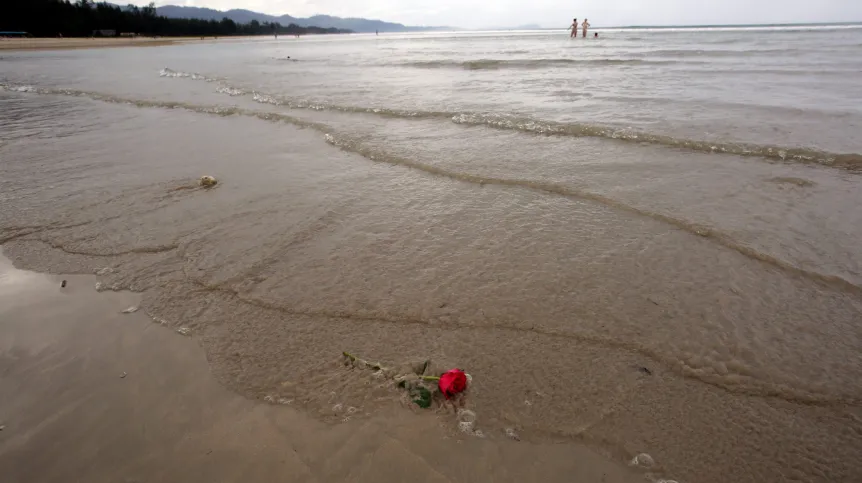
The history of the great tsunamis that came hundreds of years ago is recorded in the sands and other sediments deposited on land by water. Analysis of the sand brought that way and DNA fragments of marine animals it contains can tell scientists whether the place is also threatened by tsunamis today and how often a tsunami can occur.
In December 2004, pictures of the coast of the Indian Ocean flooded by the tsunami circulated the world. The wave caused by an earthquake caused the death of over 200 thousand people from 51 countries. One of the scientists who went to the site shortly after the disaster to look at what the flooding water brought on the land was Dr. Witold Szczuciński of the Institute of Geology, Adam Mickiewicz University in Poznań.
"We investigated whether what tsunami wave brought and left on shore, was toxic and threatened humans and animals. It was obvious that there would be increased amount of salt, but we were surprised to find elevated levels of heavy metals and arsenic" - described Dr. Szczuciński.
The scientists, who began working at the disaster site, also collected samples of sediments, both left behind by the last tsunami and older, in order to search for traces of ancient tsunamis. "If in an area affected by a tsunami we find deposits that we identify as traces of past events of this type, we gain very important information. It tells us that the coast is threatened by tsunamis. Then we can consider creating a warning system in the area" - explained the geologist.
Based on the acquired data, researchers can also try to determine the minimum range of the tsunami. "That a tsunami will occur, is one thing. The question is whether the potential wave will have two meters in height and reach several meters into the beach, or it will be a catastrophic event, during which the water breaks 5-6 km into the land" - said the scientist.
"In Thailand in 2004 we were completely surprised by this phenomenon. In the Indian Ocean tsunamis are relatively rare and until that catastrophe we did not know anything about tsunamis occurring in that region. If there were earlier studies on this topic, we would know that such events have a place there more or less every 500-600 years" - the researcher told PAP.
What types of deposits can be helpful for scientists and how can they be found? "We can examine what tsunami left now and look for something similar in the past. However, Thailand is a tropical climate zone. There are several thousand millimetres of precipitation per year - almost 10 times more than in Poland. Therefore, many chemical compounds, for example salt, have been almost completely removed from the tsunami deposits in one rainy season. Remains of marine animals, foraminifera or shell fragments are also dissolved. In such situations, we look for fragments of the DNA of these organisms in the sediment. This is a new method that we were able to introduce and test for up to 2,000 years old tsunami deposits" - the researcher described. The latest results of research conducted by his team have been published in the journal Marine Geology.
How do scientists know that the deposit they have found was left by a tsunami and not by a flood, storm or river? "Geochemistry is helpful here - we look for traces of salt and other elements typical for seawater and micropaleontological indicators, for example coverings of diatoms and foraminifers, which indicate the marine origin of the deposit. In the case of a river flooding, we would have freshwater species" - said Dr. Szczuciński.
Sometimes all it takes is to reach several-several tens of centimetres below the surface of the ground to find something. The best places are depressions, coastal lakes, lagoons. Sometimes, however, researchers need to look deeper. "What we have on the ground, is at best a record of the last few thousand years. If we want to look further into the past, we must search the deep sea sediments" - explained the scientist, who plans to take part in the expedition to the area of the Japan Trench in 2016. There, scientists will look for tsunami traces at a depth of 6-7 km below the sea surface.
The western coast of the United States: states of Washington and Oregon may be an interesting case when it comes to searching for tsunami deposits. Indian legends speak of a whale falling into the sea and splashing water that flooded the coast. "But the source of this legend was not known. Over 20 years ago traces of tsunami deposits were found there. It turned out that the whale - causing a tsunami - must have been a large earthquake. Dating shows that it took place in the year 1700" - described Dr. Szczuciński.
There are also descriptions of flooding of the Baltic Sea coast caused by the waves of catastrophic size. They concern the towns Darłowo, Mrzeżyno, Łeba. It is difficult to determine whether they were descriptions of catastrophic storms, or actual tsunamis. "One of these events - near Mrzeżyno - could indeed resemble a tsunami, as indicated by the layer of sand having the typical features of tsunami deposits. Research has shown, however, that it was a catastrophic storm of the year 1497" - said the geologist.
PAP - Science and Scholarship in Poland, Ewelina Krajczyńska
ekr/ agt/
tr. RL













